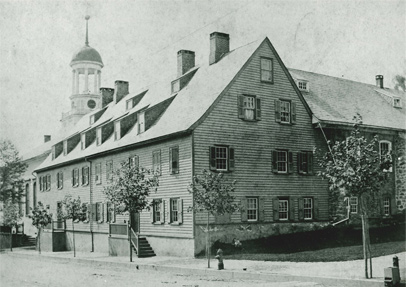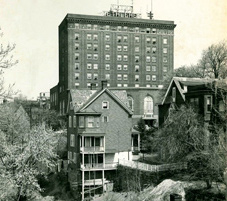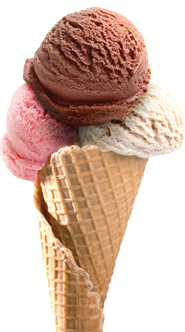Bethlehem
“A curious and remarkable town.”
That’s how John Adams described Bethlehem in 1777 and that sentiment holds true today. Situated in the center of the Lehigh Valley, within the counties of Northampton and Lehigh, Bethlehem has a population of nearly 75,000 spread amongst its almost 20 square miles, making it Pennsylvania’s 7th largest city.
History
 In 1741, a small group of Moravians from Central Europe-primarily Germany and Moravia (now the Czech Republic) – settled on the banks of the Lehigh River near the Monocacy Creek. Those early settlers started building their community with log structures along the water and what is now Church Street. By the mid 1700s a colonial industrial quarter was largely established, including two national Historic Landmarks: the 1741 Gemeinhaus, the largest 18th century log structure in continuous use in the United States, and the 1762 Waterworks, America’s first pumped municipal water system. With the onset of the Industrial Revolution, including the first discovery of ore in Bethlehem and the opening of the Lehigh Canal, cheaper mass-produced goods became more accessible and the market for handmade goods had declined. By 1844 Bethlehem was no longer exclusively a Moravian settlement.
In 1741, a small group of Moravians from Central Europe-primarily Germany and Moravia (now the Czech Republic) – settled on the banks of the Lehigh River near the Monocacy Creek. Those early settlers started building their community with log structures along the water and what is now Church Street. By the mid 1700s a colonial industrial quarter was largely established, including two national Historic Landmarks: the 1741 Gemeinhaus, the largest 18th century log structure in continuous use in the United States, and the 1762 Waterworks, America’s first pumped municipal water system. With the onset of the Industrial Revolution, including the first discovery of ore in Bethlehem and the opening of the Lehigh Canal, cheaper mass-produced goods became more accessible and the market for handmade goods had declined. By 1844 Bethlehem was no longer exclusively a Moravian settlement.
In 1845, Bethlehem officially became a borough, followed by the South Side in 1865 and the West Side in 1886. During the second half of the 1800s the New and Broad Street Bridges were built, St. Luke’s Hospital opened (1872) and the Saucona Iron Company – chartered in 1857 – reorganized as Bethlehem Steel Company In 1901 Charles Schwab purchased the Bethlehem Steel Company. That same year, West Bethlehem and Bethlehem consolidated and a large influx of immigrants from Central, Southern and Eastern Europe began. In 1918, the three boroughs – Bethlehem, South Bethlehem and West Bethlehem – consolidated to form the City of Bethlehem and Archibald Johnston became the first mayor.
Bethlehem Steel – Rise and Fall
In the early 1900s, Bethlehem Steel steadily grew and produced vast amounts of ships, armor, guns and ammunition for the U.S. and allied forces during World War I. After 1918, Bethlehem Steel continued to grow through acquisitions of steel operations and mines and in the 1930s fabricated steelwork for notable landmarks including the Golden Gate Bridge, George Washington Bridge and Rockefeller Center. With the onset of World War II, operations shifted to all-out-war production. Post World War II, the company continued to grow and expand, attracting “a new upper class to Bethlehem, and contributed greatly to Bethlehem’s tax revenue and public services.” However, by the 1960s and 1970s, the steel industry was transitioning and had to compete with the importation of foreign steel. That shift, coupled with a widening gap between management and labor, started the slow decline of Bethlehem Steel. Divisions were shut down, steelmaking capacity was reduced and by 1982 total employment was reduced by more than half. Ex-Steel employees flooded the job market and the City of Bethlehem was left to deal with the loss of its single largest financial basis. In 1995, Bethlehem Steel Corporation ended steelmaking operations in Bethlehem and ultimately filed for Chapter 11 Bankruptcy in 2001.
Revitalization of the City
 “Bethlehem could’ve gone either way,” states former Mayor Don Cunningham. Three days into his first term, the Hotel Bethlehem closed and shortly thereafter Bethlehem Steel shutdown entirely. The prime corner of a downtown that closed at 5:00 p.m. had been home to the closed Orr’s department store on one side and a gravel parking lot on the other. Saving the hotel was critical to moving downtown in the right direction. City economic dollars, in conjunction with county and federal funds and private investments, also lead to the development of the Main Street Commons and Bethlehem Brew Works, the Liberty Center (on the former gravel lot at Broad and Main Streets), the North Street parking garage and the launch of “Restaurant Row.” What had been a beautiful historic district was also now a vibrant corporate destination as well.
“Bethlehem could’ve gone either way,” states former Mayor Don Cunningham. Three days into his first term, the Hotel Bethlehem closed and shortly thereafter Bethlehem Steel shutdown entirely. The prime corner of a downtown that closed at 5:00 p.m. had been home to the closed Orr’s department store on one side and a gravel parking lot on the other. Saving the hotel was critical to moving downtown in the right direction. City economic dollars, in conjunction with county and federal funds and private investments, also lead to the development of the Main Street Commons and Bethlehem Brew Works, the Liberty Center (on the former gravel lot at Broad and Main Streets), the North Street parking garage and the launch of “Restaurant Row.” What had been a beautiful historic district was also now a vibrant corporate destination as well.
While the South Side of Bethlehem was a thriving community serving ethnic neighborhoods in the 1940s and 1950s, by the 1980s it had earned a stigma of being the less desirable side of town. The City invested in infrastructure including lighting, tree planting and a strong police presence. At that same time, Mayor Cunningham forged a relationship with then president of Lehigh University, Greg Farrington. That symbiotic partnership guided the beginning of South Bethlehem’s revitalization.
Although the thousands of lost steel jobs had a great effect on families for many years, it was not until 1998 and the loss of 20% of taxable land that the loss of Bethlehem Steel had a major economic impact on Bethlehem. As Cunningham recognized for many years, “We had to respect our city’s heritage but move on to something new.”
Moving Forward
Before leaving office in 2003, Cunningham laid the foundation for the future development of the defunct Bethlehem Steel plant that occupied over one-sixth of the 20-quare-mile city.
Today that site is home to the Sands Casino, including a 300-room hotel, the recently opened The Shoppes at Sands and the future site of the Sands Event Center. In addition, the arts and cultural campus, SteelStacks, and PSB39/WLVT both opened earlier this year on the site. And, LVIP VII now occupies 1,000 acres of the former Steel property. Though no longer supported by the Steel Industry, Bethlehem remains a thriving community full of culture, innovation, tourism and history and remains a “curious and remarkable town.”
SEE AND DO
Experience Bethlehem like never before by walking, running or biking through three centuries of the city’s history on Historic Bethlehem Partnership’s (HBP) Heritage Trail. The 80-stop trail winds its way through the north, south and west side of Bethlehem tying together the evolution of the City of Bethlehem from a small Moravian enclave to its great industrial rise to present day. The historic Heritage Trail is divided into six links: Moravian Founders, Monocacy Valley, Westward Expansion, Victorian Bethlehem, Farmlands to Industry and The Steel. The tour is available on digital recorders and iPods at the Historic Bethlehem Visitors Center and online as a download from the HPB website for smart phones and MP3 players. 505 Main Street, 1-800-360-TOUR, historicbethlehem.org
Can’t get enough history? Along the Lehigh River; The Rise and Fall of Bethlehem Steel is an on-site daily walking tour beginning at the Arts Quest Center, 101 Founders Way. The tour runs daily nine months of the year and explains the science of steel, how the blast furnaces worked and which buildings housed which operation. For more information call Historic Bethlehem Partnership at 610-882-0450 or visit historicbethlehem.org.
EAT AND DRINK
Located in the heart of downtown in the Liberty Center at Broad and Main Streets, Edge delivers fine dining in a casual, upscale atmosphere. The menu offers appetizers including Tuna Tartare and Pan Seared Foie Gras as well as a variety of small plates. In addition to regular specials, entrees include Grilled Double Cut Lamb Chops, a Triple Truffle House Grand Black Angus Burger, always cooked to perfection, and Coriander Crusted Tuna. Equally impressive, the wine list includes a wide selection of wines from around the globe. For those not quite sure what to drink, the knowledgeable and friendly bar staff will provide information and suggestions. The bar and lounge area are host to Happy Hour, Monday through Friday from 5:00 p.m. to 7:00 p.m. when specials are offered on drinks and appetizers. The restaurant includes a private dining room and will customize a menu for your special event. Liberty Center, 74 W. Broad Street, 610-814-0100, edgerestaurant.net.
 A city icon, The Bethlehem Dairy Store has been a favorite destination of ice-cream lovers for more than 85 years. Today families routinely make the store a stop before and after events held at nearby Liberty High School. Back in the 1920s and 1930s fans would line-up along Linden Street to watch soap-box derby races and then head inside for ice cream. Many require no event at all to make a visit. The menu of frozen delights includes milkshakes, banana splits and sundaes along with all the requisite toppings including hot fudge, butterscotch, caramel, Snickers, Heath bar and chocolate chips. Belgian waffles, ice cream sodas and floats and a variety of cones are on the menu as well. The homemade ice cream store is sometimes still referred to as “The Cup” by long-time residents, due to its original shape as a large milkshake cup. Still others refer to the store as “Mowrer’s,” in honor of the longtime ownership by the Mowrer family. For more than 20 years, William Burkhardt and Frederick Buckenmeyer have been co-owners of the Bethlehem Dairy Store, Inc. and in 2002 opened a second location at Campus Square on Lehigh University’s campus. 1430 Linden Street, 610-6918422 and 2 Campus Square, at New and Morton Streets, Bethlehem, 610-865-4360, bethlehemdairystore.com.
A city icon, The Bethlehem Dairy Store has been a favorite destination of ice-cream lovers for more than 85 years. Today families routinely make the store a stop before and after events held at nearby Liberty High School. Back in the 1920s and 1930s fans would line-up along Linden Street to watch soap-box derby races and then head inside for ice cream. Many require no event at all to make a visit. The menu of frozen delights includes milkshakes, banana splits and sundaes along with all the requisite toppings including hot fudge, butterscotch, caramel, Snickers, Heath bar and chocolate chips. Belgian waffles, ice cream sodas and floats and a variety of cones are on the menu as well. The homemade ice cream store is sometimes still referred to as “The Cup” by long-time residents, due to its original shape as a large milkshake cup. Still others refer to the store as “Mowrer’s,” in honor of the longtime ownership by the Mowrer family. For more than 20 years, William Burkhardt and Frederick Buckenmeyer have been co-owners of the Bethlehem Dairy Store, Inc. and in 2002 opened a second location at Campus Square on Lehigh University’s campus. 1430 Linden Street, 610-6918422 and 2 Campus Square, at New and Morton Streets, Bethlehem, 610-865-4360, bethlehemdairystore.com.
SHOP
The Knitters Edge, located in West Bethlehem at Broad Street and 15th Avenue, is large store specializing in fine yarns and the best in needles, hooks, notions and books. The latest designer knitting bags, projects bags, gadgets sacks and magazines are all available in this knitter’s playground. The store offers a large schedule of daytime and evening knitting classes for the beginner to the advanced. Children’s classes are available as well. The talented and experienced staff teaches everything from scarves, mittens, baby blankets, sweaters and more; there is also a free weekly charity class. The owners encourage knitters to come in, touch the yarn or “sit for a spell on their couch.” Dropped a stitch or need help with a project? The friendly team at The Knitters Edge will help – just stop by; there’s parking in the back. 1601 W. Broad Street, 610-419-9276, theknittersedge.com.
The newest shopping hot spot in the Valley, The Shoppes at Sands, is now open. Located at the Sands Casino Resort in South Bethlehem, The Shoppes are conveniently connected to the casino floor and adjacent to the Sands Hotel. The luxury outlet brands include Talbots, Nine West, DKNY, Lenox, Old Farmer’s Almanac General Store and Hartmann Luggage. With the excitement of the casino and its seven dining options (including a food court), and a full-service hotel next door, The Shoppes at Sands is a destination with something for everyone. 77 Sands Boulevard, 1-877-Sands77, pasands.com.
DID YOU KNOW?
• “Jimmies,” the chocolate grains sprinkled on ice cream were invented at Just Born, and named after the employee who made them.• Monocacy means “creek with many bends.”
• During the Revolutionary War (1775-1783) Bethlehem hosted such notable visitors as George Washington, Samuel Adams, John Adams and Marquis de Lafayette.
• The first annual Musikfest took place in 1984 drawing a crowd of nearly 182,000 people, compared to regular attendance of more than 1 million in recent years.
• In 1872, 75 freight trains came through Bethlehem daily.
• In 1972, when Bethlehem Steel built its new headquarters, Martin Tower, it was constructed in the shape of a cross rather than a more conventional square in order to create more corner and window offices.
• The movie theatre now known as The Boyd opened on September 1, 1921 as the Kurtz Theatre. Opening attractions included the silent film “The Great Moment” starring Gloria Swanson, which followed the vaudeville opening acts.
• Heavy metal drummer, Jimmy DeGrasso, formerly of the Alice Cooper band and Megadeth was born in Bethlehem and graduated from Liberty High School.





